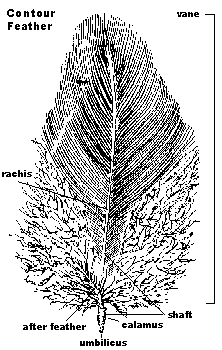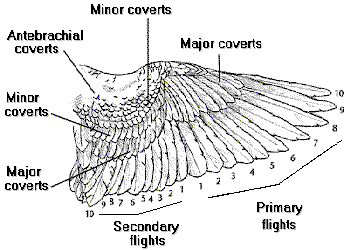Feathers are unique to birds. They provide insulation, camouflage, protection, water repellency and display. In some species of birds, the feathers of the male and female are identical. These birds are monomorphic – meaning their sex can’t be determined by their physical appearance. Other species are dimorphic – meaning the male and female look different and thus can be sexed by their appearance. Eclectus parrots are an extreme example of this. The males are green and the females red. Some species (certain ducks) have two distinct plumages or coats of feathers. The winter or eclipse plumage looks different from the breeding or nuptial plumage.
The Anatomy of a Feather
A feather is composed of several parts. The calamus is the short, tubular portion that is embedded in the feather follicle and is below the skin. The embedded tip of the calamus contains an opening known as the inferior umbilicus. The calamus of growing wings and tail feathers contains pulp (vascular connective tissue) and a small artery and vein. These young feathers are known as “blood feathers” because they will bleed if they are damaged. As these feathers mature, the pulp regresses, the vessels degenerate and the calamus becomes hollow.
The long tubular portion of the feather above the skin is the rachis. It is a continuation of the calamus above the skin. The proximal portion of the rachis (the portion nearest the body), like the calamus is also vascularized in the developing feather. The term shaft refers to both the calamus and rachis.
The vane is the portion of the feather that extends to either side of the rachis and is composed of barbs and barbules.  Barbs are slender filaments that arise from the rachis. Each barb gives rise to finer filaments known as barbules. It is these which a bird realigns when it grooms (sometimes referred to as ‘zipping’ their feathers). This ensures the waterproofing or insulation capabilities of the feathers. The vane of the feather may be soft and downy (plumulaceous) or compact and closely knit (pennaceous). A small opening, the superior umbilicus is located at the junction of the rachis and calamus. A small feather known as an after feather is often attached to this small opening.
Barbs are slender filaments that arise from the rachis. Each barb gives rise to finer filaments known as barbules. It is these which a bird realigns when it grooms (sometimes referred to as ‘zipping’ their feathers). This ensures the waterproofing or insulation capabilities of the feathers. The vane of the feather may be soft and downy (plumulaceous) or compact and closely knit (pennaceous). A small opening, the superior umbilicus is located at the junction of the rachis and calamus. A small feather known as an after feather is often attached to this small opening.
Types of Feathers
Birds have several different types of feathers. Contour feathers are the predominent feathers covering the bird’s body. Contour feathers can be divided into flight feathers and body feathers.
 The flight feathers include those of the wing known as remiges and those of the tail known as rectrices. The remiges that arise from the periosteum of the metacarpus are known as primaries, while those arising from the periosteum of the ulna are known as secondaries. The prmaries are counted (numbered) from the nearest to the body to the furthest from the body, while the secondaries are counted from the furthest away to the nearest.
The flight feathers include those of the wing known as remiges and those of the tail known as rectrices. The remiges that arise from the periosteum of the metacarpus are known as primaries, while those arising from the periosteum of the ulna are known as secondaries. The prmaries are counted (numbered) from the nearest to the body to the furthest from the body, while the secondaries are counted from the furthest away to the nearest.
The rectrices are the large flight feathers of the tail. These are counted from the center laterally. The number of remiges and rectrices varies with the species. Flighted birds may have from 12 to 9 primaries and from 6 to 32 secondaries. Most birds have 12 rectrices or tail feathers.
 Coverts are small contour feathers that cover the bases of the wing and tail feathers.
Coverts are small contour feathers that cover the bases of the wing and tail feathers.
Semiplume feathers have fluffy vanes. They are found along the margins of feather tracts. They are important in thermal insulation.
Filoplumes have a long fine shaft and short barbs or barbules. They are located very close to the follicle of each contour feather. These feathers provide sensory information about the position of adjacent contour feathers.
Bristles are specialized feathers found at the base of the eyelids, nares and mouth and have a sensory function.
Down feathers are fluffy feathers that may be found over the entire body, restricted to certain areas, or even absent, depending upon the species. Down of a newly hatched chick is known as “natal” or juvenile down, while down of an adult is known as the “definitive” down.
Powder down feathers are specialized feathers that shed a white waxy powder composed of keratin. Powder down forms a waterproof barrier for contour feathers. This powder is spread through the feathers when the bird grooms. African Grey parrots, cockatiels and cockatoos produce the greatest amount of powder on their feathers. Powder down can cause irritation to people with respiratory problems and allergies.
Next month’s column will cover how feathers grow, feather color, how birds groom and feather disorders.

